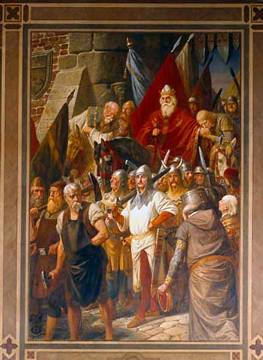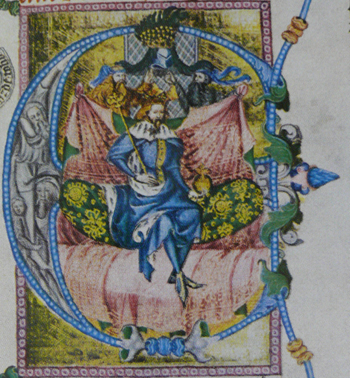|
Philip I Of Nassau-Saarbrücken-Weilburg
Count Philipp I of Nassau-Weilburg (1368 – 2 July 1429) was Count of Nassau in Weilburg, Count of Saarbrücken and Seigneur of Commercy ''Château bas'' in 1371–1429. Biography Philipp was a son of John I, Count of Nassau-Weilburg (1309 – 1371) and Johanna, Countess of Saarbrücken (d. 1381), daughter of John II, Count of Saarbrücken (d. 1381). Philipp inherited the County of Nassau-Weilburg from his father in 1371 and the County of Saarbrücken from his mother 1381. For the first ten years, his mother was the regent in his place, then bishop Friedrich of Blankenheim was the regent until his majority. Philipp married twice and had several children, and his first wife Anna brought some territories in Trier that were added to his realm. At Philipps death in 1429, the counties were ruled jointly by his eldest sons, with their mother Elisabeth as regent until 1442, then it was divided between them, Philipp getting Nassau-Weilburg and Johann getting Saarbrücken and Commer ... [...More Info...] [...Related Items...] OR: [Wikipedia] [Google] [Baidu] |
House Of Nassau
The House of Nassau is a diversified aristocratic dynasty in Europe. It is named after the lordship associated with Nassau Castle, located in present-day Nassau, Rhineland-Palatinate, Germany. The lords of Nassau were originally titled "Count of Nassau", then elevated to the princely class as "Princely Counts". Early on they divided into two main branches: the elder (Walramian) branch, that gave rise to the German king Adolf, and the younger (Ottonian) branch, that gave rise to the Princes of Orange and the monarchs of the Netherlands. At the end of the Holy Roman Empire and the Napoleonic Wars, the Walramian branch had inherited or acquired all the Nassau ancestral lands and proclaimed themselves, with the permission of the Congress of Vienna, the "Dukes of Nassau", forming the independent state of Nassau with its capital at Wiesbaden; this territory today mainly lies in the German Federal State of Hesse, and partially in the neighbouring State of Rhineland-Palatinate. The D ... [...More Info...] [...Related Items...] OR: [Wikipedia] [Google] [Baidu] |
Johann II Of Nassau-Saarbrücken
Johann, typically a male given name, is the German form of ''Iohannes'', which is the Latin form of the Greek name ''Iōánnēs'' (), itself derived from Hebrew name ''Yochanan'' () in turn from its extended form (), meaning "Yahweh is Gracious" or "Yahweh is Merciful". Its English language equivalent is John. It is uncommon as a surname. People People with the name Johann include: Mononym *Johann, Count of Cleves (died 1368), nobleman of the Holy Roman Empire *Johann, Count of Leiningen-Dagsburg-Falkenburg (1662–1698), German nobleman *Johann, Prince of Hohenzollern-Sigmaringen (1578–1638), German nobleman A–K * Johann Adam Hiller (1728–1804), German composer * Johann Adam Reincken (1643–1722), Dutch/German organist * Johann Adam Remele (died 1740), German court painter * Johann Adolf I, Duke of Saxe-Weissenfels (1649–1697) * Johann Adolph Hasse (1699-1783), German Composer * Johann Altfuldisch (1911—1947), German Nazi SS concentration camp officer executed for wa ... [...More Info...] [...Related Items...] OR: [Wikipedia] [Google] [Baidu] |
Luxembourg
Luxembourg ( ; lb, Lëtzebuerg ; french: link=no, Luxembourg; german: link=no, Luxemburg), officially the Grand Duchy of Luxembourg, ; french: link=no, Grand-Duché de Luxembourg ; german: link=no, Großherzogtum Luxemburg is a small landlocked country in Western Europe. It borders Belgium to the west and north, Germany to the east, and France to the south. Its capital and most populous city, Luxembourg, is one of the four institutional seats of the European Union (together with Brussels, Frankfurt, and Strasbourg) and the seat of several EU institutions, notably the Court of Justice of the European Union, the highest judicial authority. Luxembourg's culture, people, and languages are highly intertwined with its French and German neighbors; while Luxembourgish is legally the only national language of the Luxembourgish people, French and German are also used in administrative and judicial matters and all three are considered administrative languages of the cou ... [...More Info...] [...Related Items...] OR: [Wikipedia] [Google] [Baidu] |
Sigismund, Holy Roman Emperor
Sigismund of Luxembourg (15 February 1368 – 9 December 1437) was a monarch as King of Hungary and Croatia ('' jure uxoris'') from 1387, King of Germany from 1410, King of Bohemia from 1419, and Holy Roman Emperor from 1433 until his death in 1437, as well as prince-elector of Brandenburg (1378–1388 and 1411–1415). He was the last male member of the House of Luxembourg. Sigismund was the son of Holy Roman Emperor Charles IV and his fourth wife Elizabeth of Pomerania. He married Queen Mary of Hungary in 1385 and was crowned King of Hungary soon after. He fought to restore and maintain authority to the throne. Mary died in 1395, leaving Sigismund the sole ruler of Hungary. In 1396, Sigismund led the Crusade of Nicopolis, but was decisively defeated by the Ottoman Empire. Afterwards, he founded the Order of the Dragon to fight the Turks and secured the thrones of Croatia, Germany and Bohemia. Sigismund was one of the driving forces behind the Council of Constance (1414–1 ... [...More Info...] [...Related Items...] OR: [Wikipedia] [Google] [Baidu] |
Rupert, King Of Germany
Rupert of the Palatinate (german: Ruprecht von der Pfalz; 5 May 1352 – 18 May 1410), sometimes known as Robert of the Palatinate, a member of the House of Wittelsbach, was Elector Palatine from 1398 (as Rupert III) and King of Germany from 1400 until his death. Early life Rupert was born at Amberg in the Upper Palatinate, the son of Elector Palatine Rupert II and Beatrice of Aragon, daughter of King Peter II of Sicily. Rupert's great-granduncle was the Wittelsbach emperor Louis IV. He was raised at the Dominican Liebenau monastery near Worms, where his widowed grandmother Irmengard of Oettingen lived as a nun. Reign From his early years Rupert took part in the government of the Electoral Palatinate to which he succeeded on his father's death in 1398. He and the three ecclesiastical prince-electors (of Mainz, Cologne and Trier) met at Lahneck Castle in Oberlahnstein on 20 August 1400 and declared their king, Wenceslaus, deposed. On the next day the same four electors met at ... [...More Info...] [...Related Items...] OR: [Wikipedia] [Google] [Baidu] |
Wetterau
The Wetterau is a fertile undulating tract, watered by the Wetter, a tributary of the Nidda River, in the western German state of Hesse, between the hilly province Oberhessen and the north-western Taunus mountains. Bettina von Arnim writes of Wetterau in her text ''Diary of a Child'' in the chapter "Journey to the Wetterau". Geography The Wetterau is located north of Frankfurt am Main, on the eastern side of the Taunus and south-west of the Vogelsberg. The main part of the region is taken up by the political region Wetteraukreis. The region got its name form the small creek Wetter, but the region is crossed by several other creeks and rivers--for example, the Nidda, Nidder, Horloff and Usa. History The Wetterau has a long history and is one of the oldest cultural landscapes in Germany. It was always a very fertile region and was populous from as early as the Neolithic Age. Artifacts from successive civilizations that populated the area also exist. Prominent discoveries ar ... [...More Info...] [...Related Items...] OR: [Wikipedia] [Google] [Baidu] |
Rhine
), Surselva, Graubünden, Switzerland , source1_coordinates= , source1_elevation = , source2 = Rein Posteriur/Hinterrhein , source2_location = Paradies Glacier, Graubünden, Switzerland , source2_coordinates= , source2_elevation = , source_confluence = Reichenau , source_confluence_location = Tamins, Graubünden, Switzerland , source_confluence_coordinates= , source_confluence_elevation = , mouth = North Sea , mouth_location = Netherlands , mouth_coordinates = , mouth_elevation = , progression = , river_system = , basin_size = , tributaries_left = , tributaries_right = , custom_label = , custom_data = , extra = The Rhine ; french: Rhin ; nl, Rijn ; wa, Rén ; li, Rien; rm, label= Sursilvan, Rein, rm, label= Sutsilvan and Surmiran, Ragn, rm, label=Rumantsch Grischun, Vallader and Puter, Rain; it, Reno ; gsw, Rhi(n), inclu ... [...More Info...] [...Related Items...] OR: [Wikipedia] [Google] [Baidu] |
Landfrieden
Under the law of the Holy Roman Empire, a ''Landfrieden'' or ''Landfriede'' (Latin: ''constitutio pacis'', ''pax instituta'' or ''pax jurata'', variously translated as "land peace", or "public peace") was a contractual waiver of the use of legitimate force, by rulers of specified territories, to assert their own legal claims. This especially affected the right of feuding. Scope ''Landfrieden'' agreements formed the political basis for pursuing claims without resorting to the private use of violence. They also often regulated the jurisdiction and thus allowed the settlement of disputes through judgements based on a common set of rules. Offences or violations of the public peace were liable to severe punishment. For example, objects or buildings (such as churches, homes, mills, agricultural implements, bridges, and especially imperial roads) and people (priests, pilgrims, merchants, women, even farmers, hunters and fishermen in carrying out their work) could be placed under prot ... [...More Info...] [...Related Items...] OR: [Wikipedia] [Google] [Baidu] |
Wenceslaus IV Of Bohemia
Wenceslaus IV (also ''Wenceslas''; cs, Václav; german: Wenzel, nicknamed "the Idle"; 26 February 136116 August 1419), also known as Wenceslaus of Luxembourg, was King of Bohemia from 1378 until his death and King of Germany from 1376 until he was deposed in 1400. As he belonged to the House of Luxembourg, he was also Duke of Luxembourg from 1383 to 1388. Biography Wenceslaus was born in the Imperial city of Nuremberg, the son of Emperor Charles IV by his third wife Anna von Schweidnitz, a scion of the Silesian Piasts, and baptized at St. Sebaldus Church. He was raised by the Prague Archbishops Arnošt of Pardubice and Jan Očko of Vlašim. His father had the two-year-old crowned King of Bohemia in June 1363 and in 1373 also obtained for him the Electoral Margraviate of Brandenburg. When on 10 June 1376 Charles IV asserted Wenceslaus' election as King of the Romans by the prince-electors, two of seven votes, those of Brandenburg and Bohemia, were held by the emp ... [...More Info...] [...Related Items...] OR: [Wikipedia] [Google] [Baidu] |
Accolade
The accolade (also known as dubbing or adoubement) ( la, benedictio militis) was the central act in the rite of passage ceremonies conferring knighthood in the Middle Ages. From about 1852, the term ''accolade'' was used much more generally to mean "praise" or "award" or "honour". Etymology ''Accolade'' was first used in 1611 and is French, from Occitan ''acolada''. This, in turn, came from the Latin ''ad'' ("to") + ''collum'' ("neck") and in Occitan originally meant "embrace". ''Accolade'' is akin to "dubbing" or " to dub" since the tap on the shoulder with the knighting sword is accepted to be the point at which the title is awarded. History Ceremony The accolade is a ceremony to confer knighthood. It may take many forms, including the tapping of the flat side of a knighting sword on the shoulders of a candidate (who is himself sometimes referred to as an accolade during the ceremony) or an embrace about the neck. There is some disagreement among historians on the actua ... [...More Info...] [...Related Items...] OR: [Wikipedia] [Google] [Baidu] |
.jpg)




